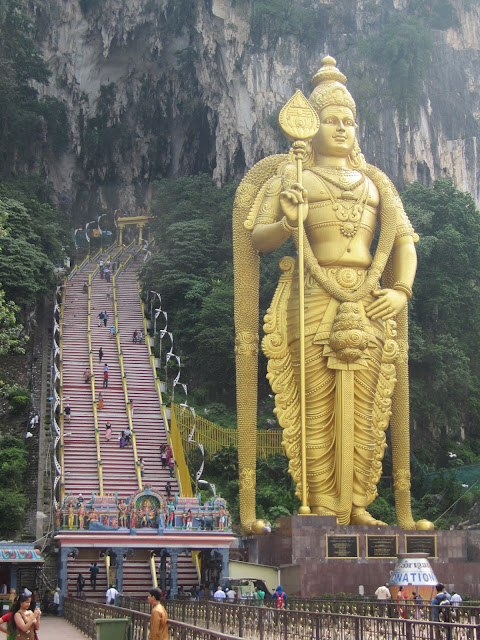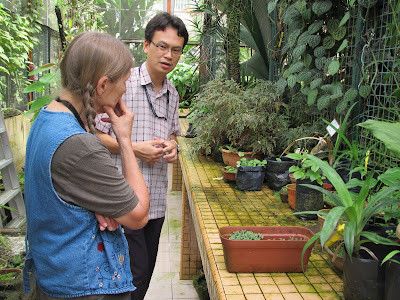 |
| Heady scents and eye-popping colors of the devotional floral market in 'Little India,' Kuala Lumpur |
Kuala Lumpur -- "KL" -- is the very large, very modern and very metropolitan capital of Malaysia. People who have never visited Malaysia might be surprised at how accessible, efficient and advanced mass transportation here is -- it's fun too! For our home base while we visited the herbaria in KL we stayed in an area called the Brickfields, very near KL Sentral, the transportation hub of KL. There's an express train from the airport right into KL Sentral, and from there it's easy to catch one of the commuter trains or light-rail trains or even the monorail to take you where you want to go. But walking is also a good way to explore the neighborhood in what they call "Little India." Getting sidetracked there was a major pastime -- being carried away by the sidewalk food-stalls and their intriguing aromas of fire & spices, the dancing reflections of sunlight bouncing off gold jewelry in all shapes and sizes, the vibrant silks of swaying, embroidered saris for sale, the bold, colorful fountains & temples, stalls festooned with lavish devotional floral offerings. It is a wonderful place just to stand back and watch what goes on!
A colorful fountain in "Little India", KL
 |
| Welcome to Brickfields, KL! |
Many Malaysians proudly claim a South Asian heritage and it shows up in the clothes, foods, temples, mosques and fountains of KL. There's a strong and living connection to Tamil Nadu in south India, but there is plenty of love for northern India too!
Open this box from the Jesal Sweet House at your own peril -- this is NOT a good place to go on diet!
 |
| Laddus and Bedas and more |
___________________________________
FRIM
Our first herbarium stop in KL was the world-famous Forestry Research Institute of Malaysia, known simply as FRIM. It is the National Herbarium for Malaysia, with origins going back to the colonial era.
 |
| The Kepong Herbarium at FRIM |
You'll find lots of plants of interest on even a casual stroll around FRIM: here is the flower Amherstia nobilis -- "Pride of Burma" -- in full glory.
 |
| Amherstia nobilis -- "Pride of Burma" |
 |
| Note the single long curved stigma, surrounded by the anthers on the ends of the pale pink filaments! |
At the Kepong Herbarium, Dr. Sam Yen Yen met us and showed us how the collections are arranged.
Here we are in the specimen preparation room -- Dr. Sam Yen Yen explains drying procedures and equipment.
 |
|
 |
| Pest control a la Kepong |
The Kepong has also incorporated one of its own innovations into pest management in the herbarium. They place dried slices of Breadfruit (Artocarpus altilis) in strategic places throughout the collection & use them to monitor beetle activity and to trap pests. I'm looking for a South Carolina fruit that would work as a substitute!
Without doubt one of the most impressive features of the Kepong Herbarium is the artistry and efficiency of Ms. Fan Yoke Kuan, a long-time member of the herbarium staff who stitches the specimens to the herbarium mounting sheets. Just watch these flying fingers!
 |
| Ms. Fan Yoke Kuan at work! |
____________________________________
THE BATU CAVES -- Underground Religion
 |
| Lord Murugan holding his vel as visitors climb to the Batu /caves |
While we were still in northern KL, we went to the Batu Caves, a series of Hindu shrines that date from the 1890s that are dominated by a massive statue of Lord Murugan.
Lord Murugan (also known as Kartikeya) is one of the sons of Shiva and Parvati. You may be more familiar with his brother, the elephant-headed god Ganesh.
The shrines are in a very large limestone cave at the top of these stairs. This is also the setting of the Thaipusam festival that attracted almost 1,000,000 pilgrims last year!
Lord Murugan (also known as Kartikeya) is one of the sons of Shiva and Parvati. You may be more familiar with his brother, the elephant-headed god Ganesh.
The shrines are in a very large limestone cave at the top of these stairs. This is also the setting of the Thaipusam festival that attracted almost 1,000,000 pilgrims last year!
Check out this video for a different look at the steps!
Inside the caves you'll find a variety of small shrines, all beautiful and seemingly right at home in the vast airy underground.
 |
| Inside the Batu Caves |
At the base of the hill at Batu you'll find different sorts of religious-themed attractions. For example, there is a large statue of the very famous and beloved Hanuman. This god is one of the heroes of the epic Ramayana (the 2,000 year-old plus story of Rama and his wife Sita and the fight to get her back from Ravana, the misunderstood king of Sri Lanka).
Here he is opening his heart to reveal his love and devotion for Rama and Sita within -- that is the epitome of piety!
_________________________________________________________
 |
| Welcome to the Ramayana Cave! |
And, of course (below), here's Hanuman again, flanked on the right by one of the very aggressive monkeys you will find ''guarding'' the entire Batu Caves complex. These monkeys will unzip and raid your backpack while it is still on your back!

 _____________________________________
_____________________________________Rimba Ilmu and the University of Malaya
Our last stop in KL was a good one! We visited the Rimba Ilmu (it means "Garden of Knowledge") research garden at the University of Malaya and also got a chance to visit the wonderful herbarium there. Dr. K.T. Yong was a great host and had invited me to speak with his class. Before the lecture he took us on a tour of the facilities.
Several of the herbaria we visited have made their seed/carpological collections into public attractions -- this is one at Rimba Ilmu is an especially nice example!
 |
| Climbing Bamboo! (Dinochloa) |
The garden at Rimba Ilmu is a real delight, planted with specialized collections and -- happily! -- all well-labelled! Can you recognize this plant growing in Rimba Ilmu? It is ''Climbing Bamboo,'' a genus (Dinochloa) of bamboo that surrounds and crawls up rainforest trees! It climbs these trees in search of more light.
 |
| Climbing Bamboo (Dinochloa) seeking another tree to climb! |
 |
| The prospect of a photo op will always perk up a post-lecture crowd! Thank you for your energy, University of Malaya students! |
It wasn't all play at the University of Malaya, as I got to speak with an enthusiastic group of students about the flora of the southwestern and southeastern US. They were an attentive and appreciative audience, and it made my task a lot easier!
________________________________________________________
We are getting near the end of the trip! In the next blog -- the last one -- we'll visit the fantastic herbarium at the Singapore National Botanic Gardens and of course re-visit the Sarawak Bodiversity Center one more time! Thanks for hanging in there for this long!










Wow that's a wonderfull blog having all details & helpful. Place strategy in kuala lumpur
ReplyDeletePeople should visit this botanical blog to get awareness about plants and flowers !! I love things near to nature and original !
ReplyDeleteFlower Delivery Kuala Lumpur
Gift Shop in Kuala Lumpur
Chocolate Bouquet Delivery Kuala Lumpur
Fruit Basket Delivery Kuala Lumpur
Cake Delivery Kuala Lumpur